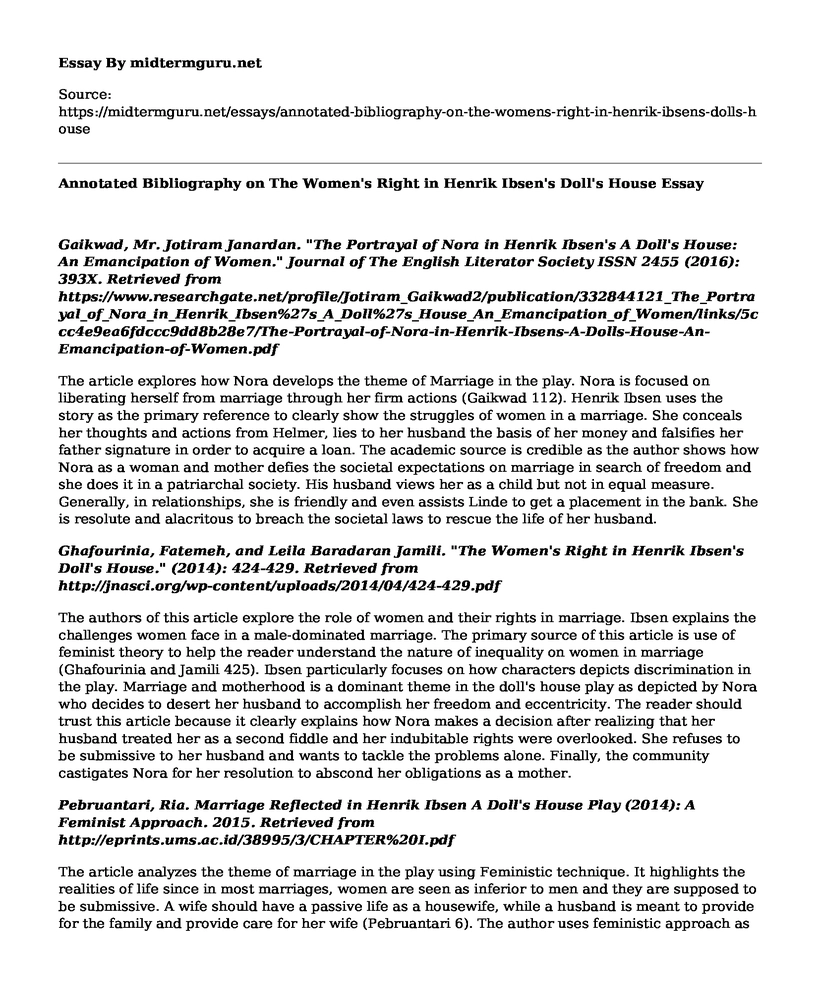Gaikwad, Mr. Jotiram Janardan. "The Portrayal of Nora in Henrik Ibsen's A Doll's House: An Emancipation of Women." Journal of The English Literator Society ISSN 2455 (2016): 393X. Retrieved from https://www.researchgate.net/profile/Jotiram_Gaikwad2/publication/332844121_The_Portrayal_of_Nora_in_Henrik_Ibsen%27s_A_Doll%27s_House_An_Emancipation_of_Women/links/5ccc4e9ea6fdccc9dd8b28e7/The-Portrayal-of-Nora-in-Henrik-Ibsens-A-Dolls-House-An-Emancipation-of-Women.pdf
The article explores how Nora develops the theme of Marriage in the play. Nora is focused on liberating herself from marriage through her firm actions (Gaikwad 112). Henrik Ibsen uses the story as the primary reference to clearly show the struggles of women in a marriage. She conceals her thoughts and actions from Helmer, lies to her husband the basis of her money and falsifies her father signature in order to acquire a loan. The academic source is credible as the author shows how Nora as a woman and mother defies the societal expectations on marriage in search of freedom and she does it in a patriarchal society. His husband views her as a child but not in equal measure. Generally, in relationships, she is friendly and even assists Linde to get a placement in the bank. She is resolute and alacritous to breach the societal laws to rescue the life of her husband.
Ghafourinia, Fatemeh, and Leila Baradaran Jamili. "The Women's Right in Henrik Ibsen's Doll's House." (2014): 424-429. Retrieved from http://jnasci.org/wp-content/uploads/2014/04/424-429.pdf
The authors of this article explore the role of women and their rights in marriage. Ibsen explains the challenges women face in a male-dominated marriage. The primary source of this article is use of feminist theory to help the reader understand the nature of inequality on women in marriage (Ghafourinia and Jamili 425). Ibsen particularly focuses on how characters depicts discrimination in the play. Marriage and motherhood is a dominant theme in the doll's house play as depicted by Nora who decides to desert her husband to accomplish her freedom and eccentricity. The reader should trust this article because it clearly explains how Nora makes a decision after realizing that her husband treated her as a second fiddle and her indubitable rights were overlooked. She refuses to be submissive to her husband and wants to tackle the problems alone. Finally, the community castigates Nora for her resolution to abscond her obligations as a mother.
Pebruantari, Ria. Marriage Reflected in Henrik Ibsen A Doll's House Play (2014): A Feminist Approach. 2015. Retrieved from http://eprints.ums.ac.id/38995/3/CHAPTER%20I.pdf
The article analyzes the theme of marriage in the play using Feministic technique. It highlights the realities of life since in most marriages, women are seen as inferior to men and they are supposed to be submissive. A wife should have a passive life as a housewife, while a husband is meant to provide for the family and provide care for her wife (Pebruantari 6). The author uses feministic approach as the primary source to scrutinize theme of marriage. The reader should trust this article since it seeks to explain the life of struggle and oppression of women in the society, drawn from Nora's situation who is treated like an object or doll. Nora is subjected to the effects of a male-dominated society, where a woman in marriage has no freedom and equal rights like his husband. Based on the feminist approach, women in marriage are harmed, oppressed, and marginalized, and thus they should be ready to battle for their rights.
Works Cited
Gaikwad, Mr. Jotiram Janardan. "The Portrayal of Nora in Henrik Ibsen's A Doll's House: An Emancipation of Women." Journal of The English Literator Society ISSN 2455 (2016): 393X. Retrieved from https://www.researchgate.net/profile/Jotiram_Gaikwad2/publication/332844121_The_Portrayal_of_Nora_in_Henrik_Ibsen%27s_A_Doll%27s_House_An_Emancipation_of_Women/links/5ccc4e9ea6fdccc9dd8b28e7/The-Portrayal-of-Nora-in-Henrik-Ibsens-A-Dolls-House-An-Emancipation-of-Women.pdf
Ghafourinia, Fatemeh, and Leila Baradaran Jamili. "The Women's Right in Henrik Ibsen's Doll's House." Journal of Novel Applied Sciences 3.4 (2014): 424-429. Retrieved from http://jnasci.org/wp-content/uploads/2014/04/424-429.pdf
Pebruantari, Ria. Marriage Reflected in Henrik Ibsen's A Dolls House Play (2014): A Feminist Approach. Diss. Muhammadiyah University Of Surakarta, 2015. Retrieved from http://eprints.ums.ac.id/38995/3/CHAPTER%20I.pdf
Cite this page
Annotated Bibliography on The Women's Right in Henrik Ibsen's Doll's House. (2023, Jan 18). Retrieved from https://midtermguru.com/essays/annotated-bibliography-on-the-womens-right-in-henrik-ibsens-dolls-house
If you are the original author of this essay and no longer wish to have it published on the midtermguru.com website, please click below to request its removal:
- Comparison of Two Heroes: Gilgamesh and Odyssey
- Essay Example: Applying the Social Developmental Model to Freedom Writers
- Essay on Janies Acquisition of Language in the Novel Their Eyes Were Watching God
- Gender Analysis of Chinua Achebe's "Things Fall Apart"
- Heroes: Who Are They? - Research Paper
- Literary Analysis Essay on 'Theme for English B' by Langston Hughes
- Essay Sample on Evolution of Othello's Character







